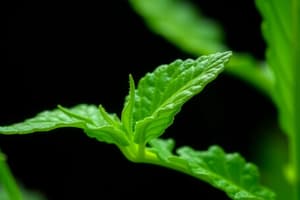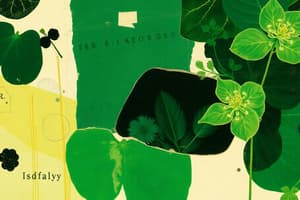Podcast
Questions and Answers
What is the main function of chlorophyll in plants?
What is the main function of chlorophyll in plants?
- To reduce NADP+
- To absorb light energy from the sun (correct)
- To reflect green light
- To synthesize ATP
What type of chlorophyll absorbs light with a wavelength of 450 nanometers?
What type of chlorophyll absorbs light with a wavelength of 450 nanometers?
- Chlorophyll b (correct)
- Magnesium ion
- Accessory pigments
- Chlorophyll a
In which part of the chloroplast do the light-dependent reactions occur?
In which part of the chloroplast do the light-dependent reactions occur?
- Chloroplast stroma
- Thylakoid membranes (correct)
- Mitochondria
- Stomata
What is the result of the electron transport chain in the light-dependent reactions?
What is the result of the electron transport chain in the light-dependent reactions?
What is the byproduct of the proton gradient in the light-dependent reactions?
What is the byproduct of the proton gradient in the light-dependent reactions?
Study Notes
Photosynthesis
Chlorophyll
- A green pigment found in plants, algae, and cyanobacteria
- Responsible for absorbing light energy from the sun
- Contains a magnesium ion at its center, which helps to absorb light
- Has a specific absorption spectrum, absorbing blue and red light, but reflecting green light (which is why it appears green)
- Two types of chlorophyll:
- Chlorophyll a: absorbs light with a wavelength of 430 nanometers (blue light) and 660 nanometers (red light)
- Chlorophyll b: absorbs light with a wavelength of 450 nanometers (blue light) and 640 nanometers (red light)
Light-dependent Reactions
- Occur in the thylakoid membranes of the chloroplast
- Convert light energy into ATP and NADPH
- Two stages:
- Light absorption: Light energy is absorbed by pigments such as chlorophyll and other accessory pigments
- Electron transport: Energy from light is used to pump protons across the thylakoid membrane, creating a proton gradient
- ** ATP synthesis**: Proton gradient is used to drive the production of ATP from ADP and Pi
- Reduction of NADP+: Electrons from the electron transport chain are used to reduce NADP+ to NADPH
Chlorophyll
- Found in plants, algae, and cyanobacteria, responsible for absorbing light energy from the sun
- Contains a magnesium ion at its center, which helps to absorb light
- Has a specific absorption spectrum, absorbing blue and red light, but reflecting green light, which is why it appears green
- Two types of chlorophyll:
- Chlorophyll a: absorbs light with a wavelength of 430 nm (blue light) and 660 nm (red light)
- Chlorophyll b: absorbs light with a wavelength of 450 nm (blue light) and 640 nm (red light)
Light-dependent Reactions
- Occur in the thylakoid membranes of the chloroplast
- Convert light energy into ATP and NADPH through a two-stage process
- Stage 1: Light absorption: Light energy is absorbed by pigments such as chlorophyll and other accessory pigments
- Stage 2: Electron transport: Energy from light is used to pump protons across the thylakoid membrane, creating a proton gradient
- ATP is produced from ADP and Pi through ATP synthesis, driven by the proton gradient
- NADP+ is reduced to NADPH using electrons from the electron transport chain
Studying That Suits You
Use AI to generate personalized quizzes and flashcards to suit your learning preferences.
Description
Learn about chlorophyll, a green pigment essential for photosynthesis, its structure, and how it absorbs light energy from the sun. Understand the two types of chlorophyll and their light absorption properties.





